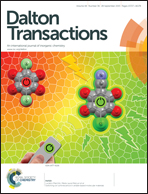In vitro photodynamic therapy based on magnetic-luminescent Gd2O3:Yb,Er nanoparticles with bright three-photon up-conversion fluorescence under near-infrared light†
Abstract
Yb3+ and Er3+ co-doped Gd2O3 nanoparticles were synthesized via a simple homogeneous precipitation method followed by subsequent heat treatment. Morphology characterization results showed that these nanoparticles were almost spherical in shape with diameters of 200–400 nm. The particles were further modified by polyethylene glycol (PEG) to improve their suspensibility in water. The sintering temperature was found to greatly influence the fluorescent properties of the products. After calcination at 700–1200 °C, the Gd2O3:Yb,Er nanoparticles could emit bright up-conversion fluorescence under 980 nm near-infrared (NIR) laser light excitation. The mechanism of up-conversion fluorescence was studied in detail and a three-photon process was observed for both green and red up-conversion fluorescence of the Gd2O3:Yb,Er nanoparticles. Different from many other Yb3+,Er3+ co-doped up-conversion materials, the prepared Gd2O3:Yb,Er nanoparticles emitted much stronger red light than green light. The reason was investigated and ascribed to the presence of abundant hydroxyl groups on the surface of the nanoparticles as a result of PEGylation. The nanoparticles could be taken up by the human cervical cancer (HeLa) cells and presented low toxicity. Well-selected photodynamic therapy (PDT) drugs, methylene blue (MB) with a UV/Vis absorption maximum (λmax) of 665 nm and 5-aminolevulinic acid (5ALA) which is a precursor of the natural photosensitizer photoporphyrin IX (PpIX) with a λmax of 635 nm, were loaded onto the nanoparticles respectively to obtain Gd2O3:Yb,Er-MB and Gd2O3:Yb,Er-5ALA nanoparticles. Being up-conversion nanoparticles (UCNPs), the taken up Gd2O3:Yb,Er nanoparticles exposed to 980 nm laser light emitted red fluorescence which activated the loaded MB and PpIX, and then killed the HeLa cells via a PDT mechanism. In vitro therapeutic investigation evidenced the prominent PDT effects of Gd2O3:Yb,Er-MB and Gd2O3:Yb,Er-5ALA upon NIR light irradiation. In magnetic resonance imaging (MRI) studies, the relaxivity values obtained for Gd2O3:Yb,Er were r1 = 2.2705 M−1 s−1 and r2 = 3.0675 M−1 s−1 with a r2/r1 ratio close to 1, suggesting that it would be a good candidate as a positive MRI agent. It is expected that these particles have applications in magnetic-fluorescent bimodal imaging and NIR light-triggered PDT.


 Please wait while we load your content...
Please wait while we load your content...